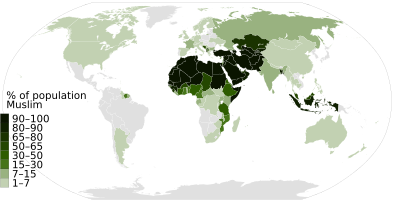More languages
More actions

Islam is an Abrahamic and monotheistic religion based on the teachings of Muhammad and the writings contained in the Quran. It is the major religion of up to 49 countries in the northern part of the African continent, West Asia, Central Asia, South Asia and Southeast Asia, with the majority of Muslims located in Asia.[1] It shares many features with Judaism and Christianity such as the prophets Abraham and Moses.[2] There are about 1.9 billion Muslims in the world,[3] making it the world's second largest religion after Christianity.
History[edit | edit source]
Muhammad[edit | edit source]
Muhammad founded Islam in 620 when he told a small group of followers that he had seen visions and that God (Allah) had spoken to him. He was driven out of Mecca in 622 and fled to Medina, where he formed a mass movement. He and his army returned to Mecca in 630 and took control of western-central Arabia, but Muhammad died in 632.[2]
Rashidun Caliphate[edit | edit source]
Muhammad's first two successors, Abu Bakr and Umar, directed their armies against the Persian and Byzantine empires, who had already been weakened by massive wars. Islam quickly spread, with Muslims conquering Damascus (Syria), Ctesiphon (Iraq), Cairo, and Alexandria (Egypt) by 642. Their use of camels allowed them to easily travel across deserts and ambush larger armies. Muslim rulers tolerated previous religions such as Christianity, Judaism, and Zoroastrianism, although many of their followers converted. Muslim rule usually increased quality of life as taxes were lowered and landlords fled.[2] The second, third, and fourth caliphs (Umar, Uthman, and Ali) were all murdered, and Mu'awiya took power in 661 following a civil war and founded the Umayyad Caliphate.[4]
Umayyad Caliphate[edit | edit source]
The Umayyads took power in 661 and held power for a century while developing strong literature, art, and agriculture.[4] They conquered Kabul in what is now Afghanistan in 664. Their armies quickly crossed North Africa and invaded the Iberian Peninsula, which they fully controlled by 711.[2]
Abbasid Caliphate[edit | edit source]
In 750, Abu al-Abbas led a revolution against the Umayyads and established the Abbasid Caliphate.[4]
Divisions[edit | edit source]
Sunni Muslims support Mu'awiya, the cousin of the third caliph Uthman, while Shi'ites support the fourth caliph Ali and his son Husayn, who also died in the civil war.[4]
Wahhabism[edit | edit source]
Wahhabism is a reactionary form of Islam created by Muhammad ibn Abd-al Wahhab in the 18th century in central Arabia. It seeks to return to the conditions of the seventh century and is supported by the Saudi monarchy.[5]
References[edit | edit source]
- ↑ “As of 2010, there are 49 countries in which Muslims comprise more than 50% of the population. A total of 1.2 billion Muslims live in these nations, representing 74% of the global Muslim population of 1.6 billion.”
"Muslim-Majority Countries" (2011-01-27). Pew Research Center. Retrieved 2022-11-24. - ↑ Jump up to: 2.0 2.1 2.2 2.3 Neil Faulkner (2013). A Marxist History of the World: From Neanderthals to Neoliberals: 'The End of Antiquity' (pp. 58–59). [PDF] Pluto Press. ISBN 9781849648639 [LG]
- ↑ Ramzy Baroud (2023-07-10). "Burning the Quran and the Counter-Offensive: Why the West Is Panicking" MintPress News. Archived from the original on 2023-07-12.
- ↑ Jump up to: 4.0 4.1 4.2 4.3 Neil Faulkner (2013). A Marxist History of the World: From Neanderthals to Neoliberals: 'The Medieval World' (pp. 61–62). [PDF] Pluto Press. ISBN 9781849648639 [LG]
- ↑ Vijay Prashad (2008). The Darker Nations: A People's History of the Third World: 'Mecca' (p. 261). [PDF] The New Press. ISBN 9781595583420 [LG]
